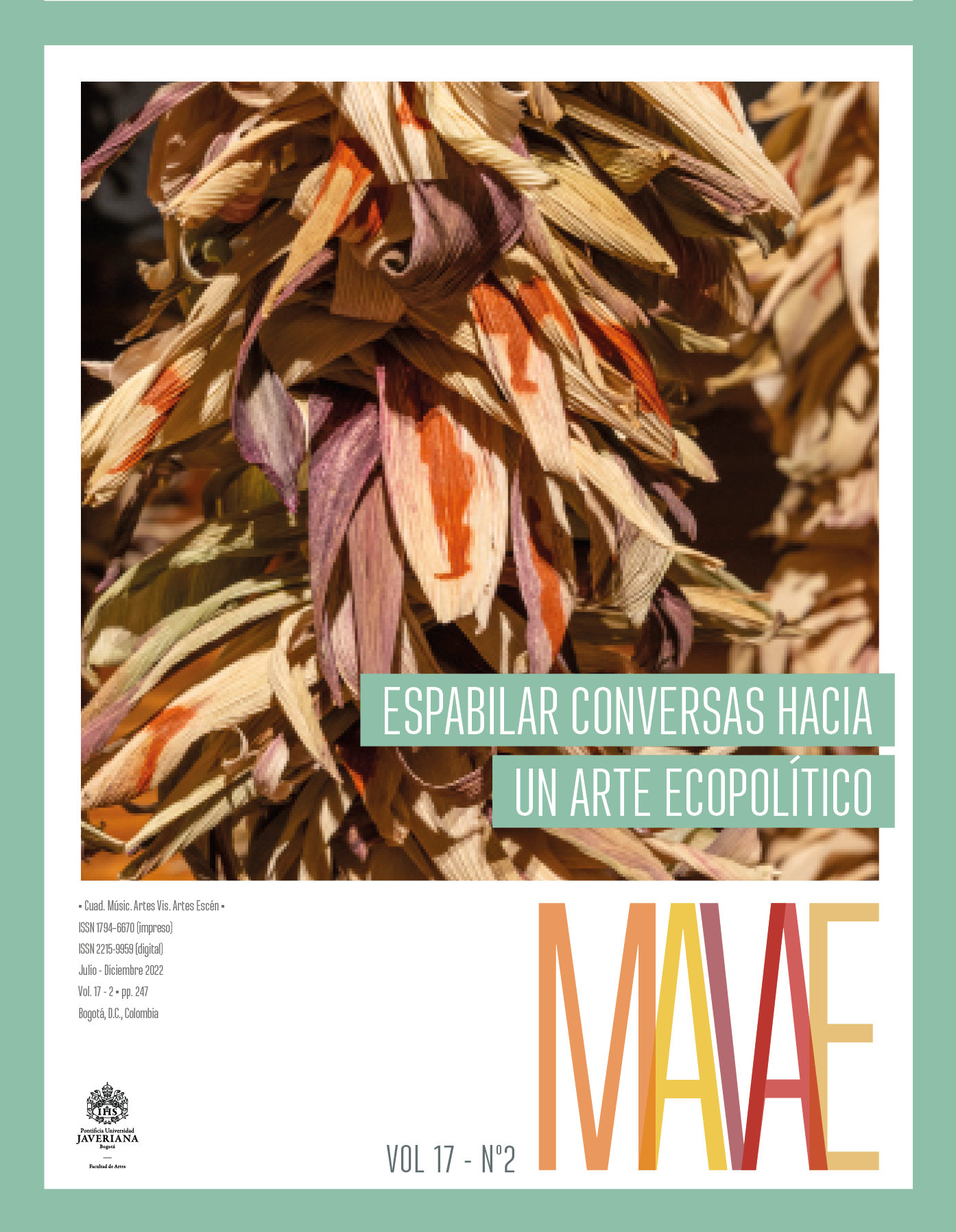Resumen
Este artículo tiene por objetivo dar las claves para la lectura e interpretación del Mapa de relaciones táctiles escala 1:1, una práctica artística desarrollada entre Eulalia de Valdenebro Cajiao y un frailejón (Espeletia grandiflora). Para ello, se describe su método de elaboración y el orden geométrico que lo estructura en tres tipos de enunciados: las proposiciones simples, los axiomas de proporción y los teoremas poéticos. En el curso de estas descripciones, se devela el valor poético y crítico de la práctica artística comprendida como un performance-gráfico de larga duración. El Mapa de relaciones táctiles escala 1:1 hace parte de una investigación más amplia en torno a las relaciones arte-ciencia en la episteme botánica moderna, donde se identifica esa manera de conocer el mundo vegetal como uno de los elementos clave que configura nuestra actual situación climática, bien expresada por Isabelle Stengers como la intrusión de Gaia. En la práctica artística de elaboración del Mapa de relaciones táctiles escala 1:1, hay una apropiación de los métodos de la episteme botánica moderna reconfigurada de manera crítica. En ella, se cuestionan elementos clave de la modernidad, como la jerarquía establecida entre sujeto-científico objeto-planta, las medidas universales, la noción de especie y el valor de verdad u objetividad del método científico. Por otra parte, el método geométrico usado propone re-visitar una modernidad espinosita que da luces importantes para la crítica de la modernidad hegemónica
Chirolla Ospina, Gustavo. 2021. Estética y política de la naturaleza a la luz del neoespinosismo. Bogotá: Pontificia Universidad Javeriana.
Cvrčková, Fatima, Helena Lipavská y Viktor Žárskỳ. 2009. “Plant Intelligence: Why, Why Not or Where?”. Plant Signaling & Behavior 4, n.º 5: 394-
https://doi.org/10.4161/psb.4.5.8276.
Danowski, Déborah y Eduardo Viveiros de Castro. 2019. ¿Hay mundo por venir? Ensayo sobre los miedos y los fines. Buenos Aires: Caja Negra.
Deleuze, Gilles y Félix Guattari. 1998. Mil mesetas: Capitalismo y esquizofrenia. Traducido por José Vázquez Pérez. Valencia: Pre-textos.
Diazgranados, Mauricio. 2013. “Aportes a la delimitación de los páramos desde el estudio de los frailejones”. En Visión socioecosistémica de los páramos y alta montaña colombiana: Memorias del proceso de definición de criterios para la delimitación de páramos, editado por Jimena Cortés-Duque y Carlos Enrique Sarmiento-Pinzón, 23- 37. Bogotá: Instituto Humboldt. http://www.humboldt.org.co/es/component/k2/item/409-vision-socioecositemica-de-los-paramos-yla-alta-montana-colombiana-memorias-del-proceso-de-definicion-decriterios-para-la-delimitacion-de-paramos.
Didi-Huberman, Georges. 2008. Ser cráneo: Lugar, contacto, pensamiento, escultura. Traducido por Gustavo Zalamea. Bogotá: Universidad
Nacional de Colombia.
Emanuele, Coccia. 2016. La vie des plantes: Une métaphysique du mélange. París: Payot & Rivage.
Hiernaux, Quentin. 2021. Philosophie du végétal. París: Vrin.
Latour, Bruno. 2019. Cara a cara con el planeta: Una nueva mirada sobre el cambio climático alejada de las posiciones apocalípticas. Buenos
Aires: Siglo XXI.
Lozano Rocha, Ana María. 2020. “Un dibujante + una mujer que posa + una pantalla + una cuadrícula o dos cortes en la sustancia del mundo”.
Cuadernos de Música, Artes Visuales y Artes Escénicas 15, n.º 1, 158-171. https://doi.org/10.11144/javeriana.mavae15-1.udum
Margulis, Lynn. 2002. Planeta simbiótico: Un nuevo punto de vista sobre la evolución. Barcelona: Debate.
Margulis, Lynn y Dorion Sagan. 2013. Microcosmos: Cuatro mil millones de años de evolución desde nuestros ancestros microbianos. Traducido
por Mercè Piqueras. Barcelona: Tusquets.
Margulis, Lynn y Oona West. 2003. “Gaia y la colonización de Marte”. En Una revolución en la evolución, editado por Juli Peretó, 225-238.València: Universitat de València.
Næss, Arne. 2017. Une écosophie pour la vie: Introduction à l’écologie profonde. París: Éditions du Seuil.
Stengers, Isabelle. 2017. En tiempos de catástrofe: Cómo resistir a la barbarie que viene. Barcelona: Ned.

Esta obra está bajo una licencia internacional Creative Commons Atribución 4.0.


